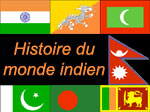Sebüktigin
- Sebüktigin
-
Subuktigîn
Subuktugîn — transcrit aussi par Sabuktagin ou Sebük Tigin — né vers 942 et mort en août 997) est le fondateur de l'empire et de la dynastie des Ghaznévides dans ce qui est l'Afghanistan aujourd'hui.
Subuktugîn naquît à Barskhan. Esclave, il épousa la fille de son maître Alptegîn, le gouverneur des Samanides de Ghaznî, lui succéda comme gouverneur en 977 et se libéra bientôt de la suzeraineté des Samanides en décadence. En 986, il défît le râja Jayapâla qui régna sur Kaboul, Lâhore et Bathinda.
Le reste de sa vie fut occupé à la conquête d'un territoire correspondant à la majeure partie de l'Afghanistan moderne. Subuktugîn mourut à Balkh pendant une campagne, après avoir désigné son fils, Ismail, comme successeur. Ce dernier est rapidement renversé par son frère ainé Mahmoud qui s'empara du pouvoir.
 Portail de l’Iran
Portail de l’Iran
Catégories : Ghaznévides | Esclave | Naissance en 942 | Décès en 997
Wikimedia Foundation.
2010.
Contenu soumis à la licence CC-BY-SA. Source : Article Sebüktigin de Wikipédia en français (auteurs)
Regardez d'autres dictionnaires:
Sebüktigin — ▪ Ghaznavid ruler in full Abū Manṣūr Sebüktigin born c. 942, , Barskhan, Afg. died August 997, Balkh founder of the Ghaznavid dynasty, which ruled much of the area of present day Afghanistan for more than 150 years. Once a Turkish… … Universalium
Sebüktigin — Sebüktigịn, Sübüktigịn, der Begründer der Dynastie der Ghasnawiden, ✝ 997 … Universal-Lexikon
Khalaf I — Abu Ahmad Khalaf (November 937 March 1009) was the Saffarid amir of Sistan from 963 until 1002. Although he was renowned in the eastern Islamic world as a scholar, his reign was characterized by violence and instability, and Saffarid rule over… … Wikipedia
Ghaznavid Empire — Infobox Former Country native name = conventional long name = Ghaznavid Empire common name = Ghaznavid Empire continent = Asia region = country = Iran era = Medieval status = status text = empire = government type = Monarchy year start = 963 year … Wikipedia
Mahmud of Ghazni — Yamīn al Dawlah Abd al Qāṣim Maḥmūd Ibn Sebük Tegīn Sultan of the Ghaznavid Empire Old French depiction of Ghaznavi reading Sultan Mahmud the Ghaznavid Afghan Emperor Rei … Wikipedia
Sebük Tigin — Abu Mansur Sebük Tigin (in English, more commonly called Sebüktegin; PerB|ابو منصور سبکتگین) (ca 942 August 997) is generally regarded by historians as the founder of the Ghaznavid Empire and dynasty in what is today Afghanistan and Pakistan,… … Wikipedia
Ghaznavid dynasty — (977–1186) Turkish dynasty that ruled in Khorāsān (northeastern Iran), Afghanistan, and northern India. It was founded by Sebüktigin (r. 977–997), a former slave. His son Mahmūd (998–1030) enlarged the empire to its greatest extent; during his… … Universalium
Military history of Iran — With thousands of years of recorded history, and due to an unchanging geographic (and subsequently geopolitical) condition, Iran (previously known as Persia in the West until 1935) has had a long, varied, and checkered military culture and… … Wikipedia
Mohammad Ghaznavi — (Persian: محمد غزنوی) (died 1041) ascended the throne upon the death of his father Mahmud in 1030. He was the younger of a set of twins; this circumstance resulted in civil strife. His reign lasted five months before he was overthrown by his twin … Wikipedia
Iran — /i ran , i rahn , uy ran /, n. a republic in SW Asia. 67,540,002; ab. 635,000 sq. mi. (1,644,650 sq. km). Cap.: Teheran. Formerly (until 1935), Persia. * * * Iran Introduction Iran Background: Known as Persia until 1935, Iran became an Islamic… … Universalium



